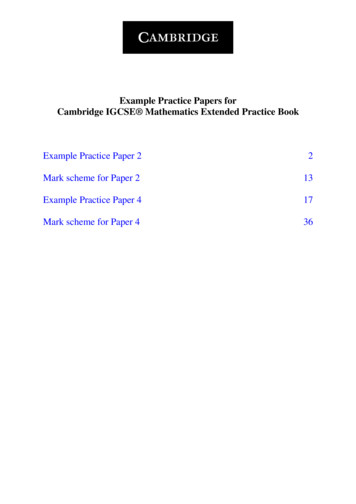Core And Extended Cambridge IGCSE Biology
CambridgeInternationalExaminationsCore and ExtendedCambridge IGCSEBiologyStudy GuideAnswer key and markscheme
CONTENTSAnswer Key1 Characteristics and classification of living organisms Chapter 2 Organisation of organisms Chapter 3 Movement in and out of cells Chapter 4 Biological molecules Chapter 5 Enzymes Chapter 6 Plant nutrition Chapter 7 Human nutrition Chapter 8 Transport in plants Chapter 9 Transport in animals Chapter 10 Diseases and immunity Chapter 11 Gas exchange in humans Chapter 12 Respiration Chapter 13 Excretion in humans Chapter246791012131416181920
14 Coordination and response Chapter 15 Drugs Chapter 16 Reproduction Chapter 17 Inheritance Chapter 18 Variation and selection Chapter 19 Organisms and their environments Chapter 20 Biotechnology and genetic engineering Chapter 21 Human influences on ecosystems Chapter2224252830323436Practice test markschemePractice Test (Paper 2) 40Practice Test (Paper 4) 41
Cambridge IGCSE Biology Study GuideAnswersExercise 1Multiple-choice questions1C6D2B7A3D8D4C9A5C10DStructured questionsQuestion1Answer34 (a)Guidance notescarbon dioxide;urea;2Marks[2]Statement ction;sensitivity / movement;sensitivity;[6]Name of ;reproduction;[5]P: Fungus;Q: Protoctista;R: Animal;For internal use only. No distribution is allowed without permission.Prepared by Anthony Mok2[3]Page 1 2017 NTK Publishing Limited
Answer KeyQuestion(b)AnswerMarksGuidance notescell wall;hyphae;saprotrophic nutrition;spores;5D, C, B, E, AFor internal use only. No distribution is allowed without permission.Prepared by Anthony Mok 2017 NTK Publishing Limited[max 2][4]Page 23
Cambridge IGCSE Biology Study GuideExercise 2Multiple-choice questions1B6C2A7C3C8C4B5BStructured questionsQuestion1234MarksGuidance notescontains cell wall / chloroplast / central vacuole;[2]Award [1] for any twostructures identified(b)cell membrane labelled correctly[1](c)cell A: 2.5 cm ൊ 0.025 mm 1000 ;[2](a)Answercell B;cell B: 3.5 cm ൊ 0.08 mm 437.5 ;Organheart;blood;stomach;TissueCellplatelet;white osome chloroplast root hair cell xylem vessels leafFor internal use only. No distribution is allowed without permission.Prepared by Anthony Mok[8][5]One less mark for eachmisplaced structure 2017 NTK Publishing LimitedPage 3
Answer KeyQuestion4AnswerMarksFunctioncontains genetic materialsto control cell activities;Ribosomesynthesizes proteins;Mitochondrion produces energy by aerobicrespiration;Cell membrane controls exit or entry ofsubstances into or out ofcell;Cytoplasmallows metabolic reactionsto take place;Cell wallmaintains cell shape /prevents the cell frombursting;Chloroplastfor photosynthesis;[7]Guidance notesCell structureNucleusFor internal use only. No distribution is allowed without permission.Prepared by Anthony Mok 2017 NTK Publishing LimitedPage 45
Cambridge IGCSE Biology Study GuideExercise 3Multiple-choice questions1C6D2A7B3B8B4D9C5DStructured questionsQuestion1(a)(b)AnswerMarkshigher concentration of bromine gas in the righthand side;[2]diffusion;increase temperature;increase the concentration of bromine gas;2nonowateryes3(a)root hair cell;(b)against concentration gradient;using energy;requires protein pump / protein carrier;(c)6Guidance noteshigh solute concentration (in root hair cell) /lowers water potential (in root hair cell);water enters by osmosis;For internal use only. No distribution is allowed without permission.Prepared by Anthony Mok[2][4][1][max 2][2] 2017 NTK Publishing LimitedPage 5
Answer KeyExercise 4Multiple-choice questions1A6B2D7C3C8A4D9A5C10BStructured questionsQuestion1AnswerGuidance notes(a)protein;amino ygen;fatty acidandglycerol;(b)2Marksheatinsulation /energystorage;[7]Benedict’s test / Benedict’s solution;warm / heat / water bath;blue to red ppt;[3](c)biuret test;blue to violet;[2](a)50 – 17;33%;[2](b)DNA is a double helix;2 strands (of polynucleotides) linked by bases;wraps around protein complexes;[max 2]For internal use only. No distribution is allowed without permission. Prepared2017 NTKbyPublishingLimitedAnthony MokPage 67
Cambridge IGCSE Biology Study GuideQuestion3(a)(b)8AnswerMarkstransport nutrients;transport wastes;dissolve food molecules in alimentary canal;reaction medium (in cells);[max 3]three dimensional shape determines function;example:active site of enzymes;shape of (binding site of) antibodies;[max 2]For internal use only. No distribution is allowed without permission.Prepared by Anthony MokGuidance notesallow specificexamples for nutrientsand wastesPage 7 2017 NTK Publishing Limited
Answer KeyExercise 5Multiple-choice questions1A6C2C7C3D4D5DStructured ogical catalyst;made of proteins;speed up rate of metabolic reactions;increase and then decrease;peaks at pH 8;enzymes are made of protein;proteins are digested in stomach;proteins are denatured by acidic pH in stomach;Marks[max 2][2][max 2]time taken decreases as concentration ofenzyme increases;[1]higher rate of reaction;more active sites available;[2]higher temperature increases kinetic energy;more successful collision;more enzyme-substrate complex formed;higher temperature denatures enzymes;[max 3]enzymes are specific to substrate;enzymes are made of proteins;sequence of amino acids determines the 3Dshape of enzyme;shape / chemical structure of active site iscomplementary to substrate;to form enzyme-substrate complex;[max 4]For internal use only. No distribution is allowed without permission.Prepared by Anthony Mok 2017 NTK Publishing LimitedGuidance notesPage 89
Cambridge IGCSE Biology Study GuideExercise 6Multiple-choice questions1A6C2B7D3B8D4B5DStructured questionsQuestion12chloroplast;[1](b)absorbs light energy;[1](c)glucose;[1](d)epithelial cell / xylem / phloem;[1](a) (i)F;[1](ii)E;[1](iii) D;[1]Name: cuticle;Function: prevents excess loss of water /prevents evaporation;[2]closely packed;high density of chloroplast;[2](a)absorbs carbon dioxide;[1](b)destarch;to make sure that the starch present isproduced during the experiment;[2](c)10Marks(a)(b)3AnswerFor internal use only. No distribution is allowed without permission.Prepared by Anthony MokGuidance notes 2017 NTK Publishing LimitedPage 9
Answer KeyQuestion(c)AnswerGuidance notesResult:no colour change;Explanation:photosynthesis did not occur;carbon dioxide is absorbed by potassiumhydroxide;carbon dioxide is required for photosynthesis;(d)MarksAward [max 2] forexplanation[max 3]Result:no colour change in white region;colour change from brown to blue black ingreen region;Explanation:chlorophyll is required for photosynthesis;glucose produced (by photosynthesis);glucose is converted into starch;For internal use only. No distribution is allowed without permission.Prepared by Anthony Mok 2017 NTK Publishing LimitedAward [max 2] forexplanation[max 3]Page 1011
Cambridge IGCSE Biology Study GuideExercise 7Multiple-choice questions1C7B2C8B3B9C4C10C5B11D6BStructured questionsQuestion1(a)(b)(c)2Marksmolar;flat surface / two roots;[2]enamel;for grinding food;[2]food remains;decomposition by bacteria;lactic acid dissolves enamel;nerve cell;[1](a)X labelling the stomach;Y labelling the gall bladder;[2]emulsification of fat;increase surface area for enzymes;[2](c)villus / villi;[1](d)thin epithelial cell layer to shorten diffusiondistance;microvilli to increase surface area;lacteal / large network of capillaries to maintainconcentration gradient;For internal use only. No distribution is allowed without permission.Prepared by Anthony MokGuidance notes[max 2](d)(b)12Answer[max 3]Page 11 2017 NTK Publishing Limited
Answer KeyExercise 8Multiple-choice questions1D6D2A7C3B8A4C9A5B10DStructured questionsQuestion1Marks(a)root hair cell;[1](b)minerals / named minerals;[1](c)cortex cell;xylem;palisade cell;[3]by transpiration;evaporation from spongy cells;diffusion out of stomata;[3]water loss by evaporation;weight decrease;[2](b)temperature;[1](c)prevent evaporation of water from soil;[1](d)2Answer(a)For internal use only. No distribution is allowed without permission.Prepared by Anthony Mok 2017 NTK Publishing LimitedGuidance notesPage 1213
Cambridge IGCSE Biology Study GuideAnswersExercise 9Multiple-choice questions1B6B2D7B3D8A4A9B5B10BStructured questionsQuestion1(a)Answername atrioventricular valve;function prevent backflow of blood (fromventricle to atrium) / AW;(b)MarksGuidance NotesA biscuspid / tricuspidvalve[2]only one ventricle in amphibian;A oraonly one artery (out of the heart / ventricle);no septum;AVP;(c)[max 2]similarities to mammalian heartR differenceboth have two / left and right atria;A more similar to fishif valid reasons areidentifiedboth have arteries / veins to lungs;(some) separation of oxygenated anddeoxygenated blood;AVP;(d)oxygenated and deoxygenated blood notcompletely / AW separated;reduce concentration gradient for gas exchange/ AW;For internal use only. No distribution is allowed without permission.Prepared by Horace Choi14[max 2][2]Page 1 2017 NTK Publishing Limited
Answer KeyQuestion(e)AnswerMarksectothermic;Guidance notesR “cold-blooded” /“poikilothermic”slower metabolism;gas exchange through skin;AVP;2(a)hepatic portal vein;(b)artery has thicker wall;[max 1][1]A oraartery has smaller lumen;artery has more muscle / elastic fibres;artery does not have valves;(c)[max 2]thin wall;A ecf from (a)large lumen;few muscle / elastic fibres;valves;(d)[max 1]more oxygen in vessel P;A oramore nutrients / named nutrient in vessel P;A more / less glucoseif correctly explainedless urea;less carbon dioxide;AVP;(e)[max 3]ref to diffusionrequirednutrient / named nutrient / oxygen diffusesfrom tissue fluid to cell;waste / named waste diffuses from cell to tissuefluid;plasma pushed out of capillary (to form tissuefluid);due to high blood pressure;(f)[max 3]injury to blood vessels causes blood clotting;ref to process of blood clotting;blood clot blocks blood vessels / thrombosis;R “heart” alonereduce / block blood flow to heart muscles;less glucose / oxygen supplied to heart muscles;heart (muscles) cannot contract;ref to respiration;[max 5]For internal use only. No distribution is allowed without permission. Prepared2017 NTKbyPublishingLimitedHorace ChoiPage 215
Cambridge IGCSE Biology Study GuideExercise 10Multiple-choice questions1A6A2D7D3C8A4C9B5A10BStructured questionsQuestion1Answer(a)pathogen;(b)mosquitoes puncture skin / blood vessels;MarksGuidance notes[1]Plasmodium directly introduced into blood;ref to methods to evade defences inside body;(c)A oramosquitoes live in warm and humid areas;mosquito species transmitting malaria are onlyfound in (Sub-Saharan) Africa;(d)[max 2][max 1]insect repellent;insecticides;AVP;(e)[max 1]stimulate immune response / ref to primaryresponse;formation of memory cells;memory cells produce antibodies quickly / ref tosecondary response;eliminate pathogen quickly;16For internal use only. No distribution is allowed without permission.Prepared by Horace Choi[max 3] 2017 NTK Publishing LimitedPage 3
Answer KeyQuestion(f)AnswerMarksGuidance notesPlasmodium / malarial parasites live inside redblood cells;cannot be targeted by antibodies;move into (liver) cells quickly after infection;many species of Plasmodium / malarialparasites;AVP;[max 3]For internal use only. No distribution is allowed without permission. Prepared2017 NTKbyPublishingLimitedHorace ChoiPage 417
Cambridge IGCSE Biology Study GuideExercise 11Multiple-choice questions1B6D2A7D3A8D4A9C5C10AStructured questionsQuestion1(a)AnswerMarks2.8 (dm3);A answers between2.7 and 2.9[1](b)measure time taken for multiple e.g. 10ventilations;A description formeasuring rate involume per minutecalculate length of 1 ventilation (by dividingmeasured time by number of ventilations);divide 60 by time of 1 ventilation;(c)[2 max]total volume (of air) remains constant;distance between peaks / troughs increase(over time) / AW;A frequency /ventilation rate /breathing ratedifference between peak and trough increases;A “amplitude” / “tidalvolume” / “depth ofbreathing /ventilation”[3](d)Guidance notesdifficulty of ventilation;I ref to rate / depththoracic cavity not airtight;lung volume does not change with thoraciccavity / AW;cannot change / control pressure in lungs / AW;18For internal use only. No distribution is allowed without permission.Prepared by Horace ChoiA “lungs cannotexpand and contract”[max 3] 2017 NTK Publishing LimitedPage 5
Answer KeyExercise 12Multiple-choice questions1D6B2B7A3B8A4D9C5B10AStructured questionQuestion1(a)Answerchemical reactions (in cells) that break downnutrient / organic molecules to release energy/ AW;without using oxygen / in absence of oxygen /AW;(b)MarksR “produce”[2]type of respiration aerobic;explanation air / oxygen supplied to / pumpedinto set-up;[2](c)remain unchanged / colourless / AW;carbon dioxide is removed / absorbed bysodium hydroxide;(d)R ref to amount ofenergy from anaerobicrespirationR “clear” /“transparent”[2]R “no carbon dioxide”A correct description ofset-upsame set-up of apparatus;without mammal / animal;[2](e)Guidance notesA appropriate non-livingsubstitute e.g. stonefrom red to yellow;carbon dioxide produced by mammal;carbon dioxide concentration increases;no photosynthesis;A correct ref to acidity /pHA absence ofphotosynthetic[max 3] organismsFor internal use only. No distribution is allowed without permission. Prepared2017 NTKLimitedbyPublishingHorace ChoiPage 619
Cambridge IGCSE Biology Study GuideExercise 13Multiple-choice questions1A6B2D7D3B8D4C9D5D10BStructured questionQuestion1(a)AnswerMarksGuidance noteshigh (blood / hydrostatic) pressure inglomerulus;pressure (in glomerulus) pushes plasma intoBowman’s capsule;basement membrane blocks large molecules(and blood cells);formation of glomerular fi
Cambridge IGCSE Biology Study Guide Core and Extended Cambridge International Examinations Answer key and markscheme. CONTENTS Answer Key Chapter 1 Characteristics and classification of living organisms 2 Chapter 2 Organisation of organisms 4 Chapter 3 Movement in and out of cells 6
IGCSE First Language English 12 IGCSE World Literature 13 IGCSE English as a Second Language 14 . IGCSE Business Studies 19 IGCSE Global Perspectives 21 IGCSE Geography 22 IGCSE History 23 IGCSE Sciences 24 IGCSE Cambridge Mathematics Extended & Core 26 . At BISP, Year 12 and 13 (Key Stage Five) students study the IB Diploma Programme (IBDP .
IGCSE ARABIC for Native Arabic Speakers - Edexcel 11 GCSE ART & DESIGN - Edexcel 13 IGCSE BUSINESS STUDIES - Cambridge 15 IGCSE ECONOMICS - Cambridge 17 IGCSE COMPUTER SCIENCE - Cambridge 19 GCSE DRAMA - Edexcel 20 IGCSE ENGLISH LANGUAGE - Cambridge 22 IGCSE ENGLISH LITERATURE - Edexcel 22 IGCSE GEOGRAPHY - Edexcel 25
University of Cambridge International Examinations London GCE AS/A-Level / IGCSE / GCSE Edexcel International. 6 Examination Date in 2011 Cambridge IGCSE Oct/Nov X 9 Cambridge GCE / May/Jun 9 9 London GCE London GCSE May/Jun 9 X Chinese London IGCSE Jan X 9 Cambridge IGCSE / May/Jun 9 9 London IGCSE London GCE Jan 9 9 Cambridge GCE Oct/Nov X 9 Private Candidates School Candidates Exam Date. 7 .
Upcoming Cambridge IGCSE training in Rome 05-06 April 2017 Introductory Cambridge IGCSE English as a Second Language (0510) Introductory Cambridge IGCSE International Mathematics (0607) Introductory Cambridge IGCSE Art and Design (0400) Extension Cambridge IGCSE Geography (0460) 07-08 April 2017
Mathematics for Cambridge IGCSE Complete Science for Cambridge IGCSE Complete Business Studies for Cambridge IGCSE & O Level Trusted by teachers and students around the world, our popular Core and Extended Mathematics books have been fully updated for the latest Cambridge IGCSE syllabus
Cambridge IGCSE Physics 0625. Examination in June and November 2011. 2. Assessment at a glance Cambridge IGCSE Physics Syllabus code 0625 Cambridge IGCSE Physics candidates are awarded grades ranging from A* to G. Candidates expected to achieve grades D, E, F or G, study the
complete until we have received your payment. Please avoid paying on last day of normal stage . IGCSE CAMBRIDGE INTERNATIONAL EXAMINATIONS MAY/JUNE 2021 IGCSE FEES IN NAIRA . IGCSE GEOGRAPHY 0460 AY 57,255.00 88,529.00 133,730.00 IGCSE GEOGRAPHY 0460 BY 58,142.00 89,416.00 134,617.00 IGCSE GEOG
Cambridge IGCSE Mathematics Extended Practice Book Example Practice Paper 2 1 hour 30 minutes PLEASE NOTE: this example practice paper contains exam-style questions only . 2 Written specifically for the publication ‘Cambridge IGCSE Mathematics Core Practice Book’. Cambridge International Examinations does not take responsibility for this .























